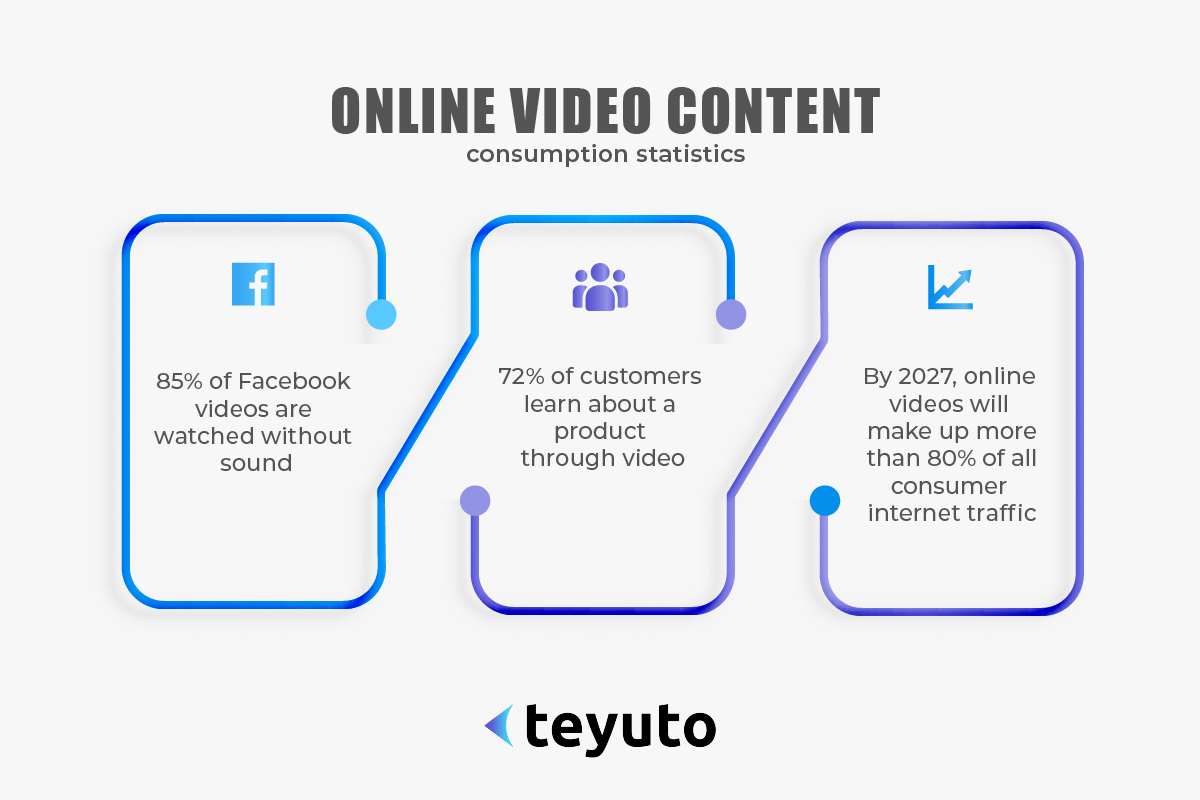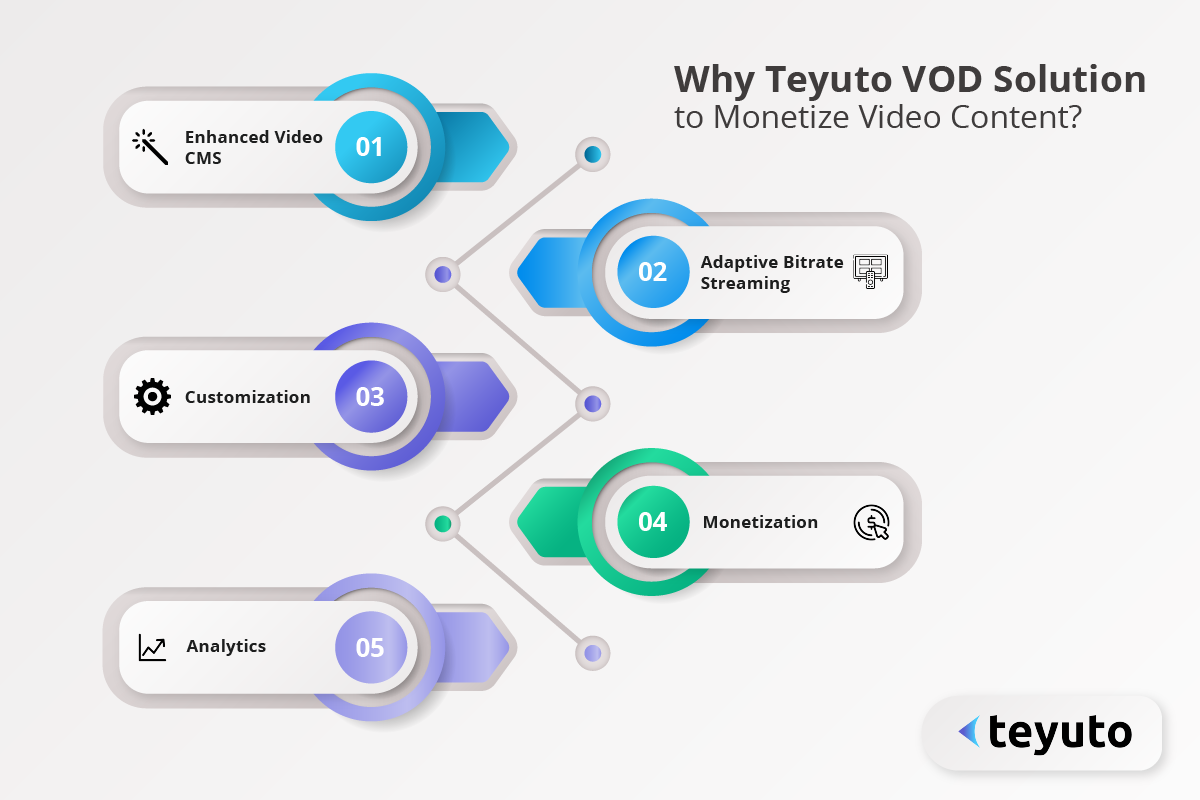

Videos correspond to the highest traffic on the internet. It is the best format for consuming content and offers a dynamic mechanism to reach the viewers.
“On average, people in the US spend 323 minutes a week watching videos.”
The online video market offers a unique opportunity for anyone wanting to create their own streaming service (OTT). With the growth of the streaming market and the number of streaming services like Netflix, Amazon Prime Video, Disney+, and others, cloud video platforms have opened new horizons where people can reach their favorite content conveniently.
It’s not as if creating and uploading a video online will automatically bring internet traffic to you. Selling these videos is a different ballgame altogether. So, how to reach your audience and monetize your video library?
Video monetization has become popular for content creators to make a living out of their skills doing what they love. With the rise of online video platforms and digital marketplaces, it has become easier than ever before to sell videos online. This tutorial will discuss the steps to develop your rockstar video monetization strategy. Let’s begin!
Step 1: Identify your niche and target audience

Before creating and selling videos online, you must identify your niche and target audience. Your niche should be something you are passionate about and have expertise in. This will help you to create high-quality videos that your target audience will find valuable and engaging.
There are almost no limits to the type of videos you can create.
Only one thing is essential: you must offer real added value to the viewers. Otherwise, your viewers will likely not return or cancel their membership.
For example, your videos should be entertaining, educational, and preferably both.
Examples of possible video types are:
- Video Courses & Webinars
- Tutorials
- Movies & Series
- Documentations
You must define your target group and design the content for your niche. There are numerous topics for OTT content; for example.
- Sports programs or tutorials
- Nutrition and cooking videos
- Programming courses
- Language courses
- Software tutorial
- Talk shows
Some relevant online video content consumption statistics to consider:

- 85% of Facebook videos are watched without sound
- 72% of customers would instead learn about a product or service through video
- By 2027, online videos will make up more than 80% of all consumer internet traffic
Step 2: Create high-quality videos
The success of your video business depends on the quality of your videos. Therefore, it is crucial to invest time and resources into creating high-quality videos that are visually appealing and engaging. You can use a high-quality camera, professional lighting, and an excellent microphone to ensure your videos are top-notch.
Video editing tools
Live broadcasts, streams, and online interviews are a new must-have for every business that wants to be in trend and get traffic and loyal customers. However, you need a good video editing and mixing tool to make your broadcasts attractive. For video editing, you can try solutions like Adobe Premiere Pro or PowerDirector 365. For broadcasting (including multi-camera broadcasting), you can try solutions like Open Broadcaster Software and Teyuto.
Computer, phone, or tablet?
Let's start with the apparent foundation. You will need a streaming device. You can broadcast from your smartphone, console, desktop, or laptop. It all comes down to the quality and level of functionality you are looking for.
Having streaming hardware (encoder) at the source is always good. This is because video encoding is an intensive task that consumes many system resources, which might even crash a personal device. However, you can stream via personal devices, including laptops and smartphones. Do a couple of test runs before engaging your audience to avoid issues.
Camera
One of the essential tools for live broadcasting is a video camera. If you are testing live broadcasts, begin with a simple camera setup. It can be a laptop or smartphone camera, action camera, entry-level camcorder, or other options. It will not bloat your budget and will work adequately in good lighting conditions. Upgrade to a professional camera whenever you get a chance.
Sound Equipment

Imagine: you are broadcasting. The picture is incredible. The light, the product - everything is fine. But the sound stutters and disappears. You need a stable audio output for the viewer to not drop off the chat.
The built-in mics on entry-level cameras and phones provide decent audio quality, but you can improve it with a primary wired 3.5mm mic. It will help you focus on your voice, not some strange noise outside the window. You can also purchase a condenser microphone with a desktop stand. It will give a professional sound (but also limit your movement).
Some tips for creating high-quality videos:
- Use a script to stay on track and deliver your message effectively
- Use high-quality visuals and graphics to enhance the overall appeal of your videos
- Ensure that your videos have good lighting and sound quality
- Keep your videos short and to the point, with a maximum duration of 5 minutes (unless you’re creating long-form content).
Step 3: Choose a platform to sell your videos

Can content producers have their own OTT streaming channel? Creating your own OTT (Over The Top) streaming channel is a great way to expand the content reach to your audience. For content producers, this means more possibilities to expand their audience and reach new markets.
With OTT streaming platforms, producers can have their channels with exclusive content that users can access worldwide.
The first thing to consider when creating your own OTT is choosing a compatible streaming service. Several streaming services are available, but choosing the one right for your content and budget is essential. Also, ensuring the streaming service you select has the resources to support your service needs is crucial.
Making money with your OTT channel can be a challenge, but it can also be an excellent opportunity for anyone with an entrepreneurial vision. There are several ways to earn money from your OTT channel that can help increase your profits.
Here are some of the best OTT video monetization solutions to consider:
Teyuto
Teyuto offers the most features and unprecedented customization, which beats all other solutions mentioned in this list. It equips you with a powerful cloud video CMS and ensures you retain maximum profits. Teyuto has zero platform fee for any membership or transaction routed via the platform. On top of it, you can begin using the platform at no cost using its “Free” package. The robust platform with a resilient customer support team is worth trying.
Brightcove
Brightcove has you covered with various advertising, pay-per-view, and subscription options for making money off of your videos. In addition to providing statistics and video optimization tools, Brightcove provides a wide variety of tools for creators.
Kaltura
Kaltura is a video hosting service that provides producers multiple ways to earn money, including pay-per-view, subscriptions, and advertising. Tools for creators are also available on Kaltura, including analytics, video editing, and video optimization.
Dacast
Dacast is a video platform that provides many ways for content providers to earn money, such as pay-per-view, subscription, and advertising. In addition to its analytics, video editing, and optimization capabilities, Dacast provides various tools for creators.
Vimeo
Vimeo is a high-quality video hosting platform that supports multiple business models for generating revenue. Vimeo allows 360-degree and high-definition video uploads, comprehensive analytics, and flexible player settings.
Step 4: Choose A Monetization Model
Successful business cases prove different monetization models. Choosing a monetization model requires proper knowledge of your audience, content, and plans to expand and develop the service.
TVOD, SVOD
VOD (video on demand) includes SVOD (subscription-based like Netflix) and TVOD (transactional like Udemy) models, which are subscription and pay-per-view, respectively.
Each model has pros and cons, including specific stages in developing a service or platform. The good news is that both can be combined into a hybrid VOD model. A hybrid of TVOD and SVOD monetization models offers subscriptions and one-time purchases, potentially helping attract and retain a large audience.
AVOD
AVOD is slightly different from other VOD models as this monetization model is ad-based and is designed to monetize not only from the audience but also from brands looking to engage your users. The AVOD model generates revenue through ads shown before and during the video (like YouTube). Ads are targeted at a specific demographic group and are associated with the behavioral characteristics of the selected group.
Advertising
Advertising can be shown while downloading or watching a TV channel, movie, or series (pre- and mid-rolls). Also, an advertisement may be present as a banner.
The right advertising campaign consists not only of a video or an image; it requires advanced targeting and analytics technologies. Teyuto pays special attention to audience analytics and also provides detailed revenue reports.
With Teyuto, you have complete solutions for your personalized online broadcasting platform. It allows excellent branding options and a perfect content management system that enables users to manage their video content with in-depth analytics.
Step 5: Research Customer Insights

Video-based selling is no longer a novel trend that will get you instant buyers. You will need a plan for it. Understanding your audience's interests, preferences, and behaviour is crucial for producing engaging video content that resonates with them. By leveraging customer insight, you can customize your video content, resulting in the following:
- Increased engagement
- Higher retention rates
- More revenue.
You can imagine the customer persona you want to target.
For a great customer experience, 86% of buyers are willing to pay more.
To get better insights, you can use the following popular tools:
Google Trends
Google Trends is quite popular among digital content creators; it will also help you understand search different keywords to check which has a higher search volume. Furthermore, to get accurate data, it is highly recommended to integrate and use Google Search Console on your platform.
This tool helps you find the right customers by showing how people use Google to find and connect with your website. By knowing what search terms people use to find your site, which pages get the most clicks and views, and how users act on your site, you can improve your content and website to meet the needs of your target audience better.
Google Search Console can assist you in reaching the right audience in the following ways:
Search Query Analysis:
You can find keywords your target audience uses to find your site. You can use this information to improve your content.
Click-Through Rate (CTR) Optimization:
You can see which of your pages get the most clicks and views by looking at the CTR for each page in Google's search results. With this feature, you can make your page titles and descriptions more appealing to the people you want to reach.
Site Performance Analysis:
You can find areas of improvement by looking at how people use your website. This knowledge can help you improve the user experience on your website and increase the number of people interested in buying your content.
Facebook Audience Insight
Facebook Audience Insight will help you capture information about demographic characteristics (age, occupation, and gender) or even user behavior on Facebook.
In addition, you can discover who has liked your fan page and learn about your competitors' customers, from which you can devise a strategy to make better video sales content.
Pay Attention to the Disclosure
Last but not least, it's time to invest a lot in advertising. It will be an essential part of your strategy. With that in mind, try to promote your content in the most intelligent way possible to reach your potential audience.
In that case, it's worth returning to planning and putting yourself in your audience's shoes again: which social media platform is your audience more likely to use? What is their preferred language? How can you make your content relevant to them?
Your promotion strategy may include teasers, providing a free video as a “sample,” marketing investment for organic results, or paying to boost. Run several tests and see what brings the best results!
Five metrics that will help you when tracking the results of your videos
Number of views
This is usually the most fundamental metric companies observe. The amount of people who viewed the video is not the most profound insight as it does not inform you about anything other than “the number of video plays.” However, it is still a key insight.
Note: On Facebook, to be counted as a view, a person has to watch the video for at least three seconds.
Retention time
Once you see the total viewers, pay attention to the Watch Time, i.e., the retention rate. This number shows how many seconds of the video the audience watched over the total time. It is fascinating to compare this metric with the previous one. For example, if out of 1,000 views, only 2% watched the video until the end, you need to make the content more relatable to your audience.
Click-Through Rate
It's the number of people who managed to play the video, which can be measured by the total number of visitors to the page. This amount is expected to be high, as videos provide good engagement. For instance, YouTube claims that between 2% and 10% of views result in a click-through rate.
So, if something different happens on your page, changing your page layout or user interface becomes important.
Video engagement rate
Video engagement rate means “the percentage of impressions that have resulted in some form of engagement”, including views, likes, shares, etc. So, for example, if your video gets 1000 views and 300 engagements, you have a 30% engagement rate. All the numbers mentioned before reveal who watched the video. But, you need to go further and evaluate who engaged in that content, so get in the habit of raising the number of likes, comments, and shares. Remember that shares have more excellent value than comments, which are more significant than likes.
It is essential to pay special attention to the number of shares because they reveal the potential for the virilization of that video. The greater the number of people who share, the greater the indication that you are on the right path!
Why is Teyuto the best choice to sell your video content?

Teyuto helps large enterprises and companies deliver live, on-demand videos to their audiences. This video platform supports over-the-top (OTT) videos, ads, and even advanced analytics.
One of the best things about this video solution provider is that, unlike YouTube, you retain all ownership rights to your video content. This ensures that your videos do not suffer due to copyright infringement.
Teyuto's focus is on large-scale video distribution. The platform also integrates easily with other tools. These integrations allow you to support multiple forms of marketing and deliver higher returns.
Features:
Without writing a single line of code, Teyuto's enhanced video CMS handles all your concerns about managing VOD solutions. It also offers comprehensive video analytics and API.
Here is a list of the platform's essential features:
- Cloud-based transcoding
- Custom video portals
- Dynamic ad insertion
- Support 24 hours a day, seven days a week
- Adaptive bit rates
- Supports streaming on all devices
- Easy integration with marketing and social media tools
- Compatible with multiple file formats
- 0% platform fee on transactions
- Drag-and-drop channel builder and customizations
Conclusion
Selling your video content on the internet is a great initiative. If you have the opportunity to create quality materials, go for it! Remember to consider the importance of good planning, but rely on it with others. Your cloud video channel can succeed with quality equipment, the right platform, and effective promotion.
Now that you know the essentials, it's time to start. So take advantage of your ideas or projects and get to work!


Enjoyed this read?